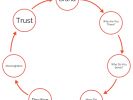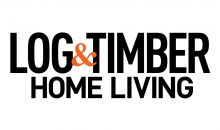Build Your Brand, Build Your Circle, Build Your Influence - Part One
What is branding, and how do you do it? While we may think it means looking inward at what we do and how we do it, and then telling people about those things, Mitch Anthony taught us that branding is really about how we are perceived and who we show ourselves to be. “What do people think of – how do they feel – when they consider your company?” was the prevailing question of the recent branding summits offered by the Timber Framers Guild.

At the recent Craft of Business Summits in Brattleboro, Vermont, and Portland, Oregon, the one constant that we heard was that the first steps is to reach out, talk to your clients and learn from them what they are thinking. So how do you find out what they are saying?
It’s simple: ask them.
You do not need to talk to your customers with specific questions but have a conversation based on common prompts. The objective is to listen openly and not guide what they say. The focus is on making your client feel heard and respected. Mitch insisted that most successful interviews are those in which your client does the vast majority of the talking. Listening and taking notes is your part.
Step 1 – Choose your interviewees.
Mitch says you do not need to talk to a lot of people (12-15 is more than enough) before you see significant patterns emerge. So, how do you choose who to talk with? Here’s how to narrow down your list:
- Who represents an ideal client or customer?
- Who are the people who get your offer without a lot of explanation?
- Who represents a frustrated or disappointed client or customer? Very often we can learn more from those who represented a challenge in some way than those with whom the relationship was easy.
- Who represents someone who is a natural cheerleader for your offer?
- Who is out there already spreading the good word?
- Who do you purchase materials or supplies from? What is their perception of your strengths and weaknesses?
Step 2 - Schedule the talk.
In an email or a phone call, tell your client that you are trying to improve your offer and brand. Explain that you would value their honest voice about their perceptions and experience of your company, services, and products.
Promise that you will need no more than 30 minutes, and maybe even less. Always be respectful of their time.
Schedule the day and time for the talk. In your reply email offer a few times and different days to meet up but always defer to their schedule. Their time is important.
Step 3 - Record your conversation.
Note: Before you record any conversation, ask for the client’s permission to do so.
You can use Uber Conference or Zoom.us for this purpose. These are free online services. Recording the call is as simple as hitting a button, and you can download an MP3 file of the call immediately afterward. You can then use a service like speechpad.com to create a written transcript of the conversation.
That conversation, plus your own detailed notes, will be enough information upon which you can base your decisions and next steps.
Step 4 - On the Call
First, get the demographics out of the way first (you may be able to answer questions about demographics if you have worked with the client):
- What is your household size?
- Age?
- Married? For how long?
- Kids? How old?
- What is your profession?
- What is your education level?
This should only take 3-4 minutes.
Now that you have some baseline information about the person you’re interviewing, it’s time to learn about their perspectives. Remember, this is an interview, not a survey. Use the prompts, then step aside and let your client have the floor. These questions can be customized, obviously, based on what your company has to offer and whether you are an architect, timber framer, or supplier.
At the end of the day, your brand is not about you, it’s about how your brand helps those you serve meet their own personal needs and interests. So use this interview as an opportunity to ask questions like:
- How did you first learn of ____________?
- Imagine that we are seatmates on an airplane. If I asked you to describe ________________ to me, an interested stranger, how would you do so?
- How would you describe my product to a friend?
- How, specifically, does _____________________ meet your needs? How does it help you? What of your needs does it help you meet?
- What do you think that _____________________ does really well?
- What things do you think that ______________ could do better?
- Has there ever been a time when _________________ didn’t meet your needs?
Step 5 - Listen, don’t judge.
The purpose of this interview is to listen. While later in the brand design process you’ll be connecting some dots and drawing some conclusions, for now you’re simply listening. Try your best not to draw conclusions or to reconcile apparent contradictions in the interview or after.
The understanding and insight that can be revealed by listening is powerful and unparalleled. It can be the basis for a clear brand, an effective communications platform, and new strategic initiatives. However, those things come later.
In the next article, we’ll start to discuss what is next, now that you have all of this information, and get you on your way to defining your brand.
A good deal of the contents in this article are taken from Mitch Anthony and his article at https://clarity-first.com/how-to-talk-so-stakeholders-will-listen-and-listen-so-stakeholders-will-talk/.
Click on a photo to enlarge.
This blog article has been viewed 128 times.
Posted
Jan 9, 2018 6:55 AM PST.
Edited on Jan 10, 2018 8:18 AM.report
New Blog Posts
- Hidden Trace Farm CBW: Arrival
285 views - Heartwood 2020: Timber Framing II
250 views - Heartwood 2020: Timber Framing Intensive, July 9
118 views - Heartwood 2020: Timber Framing Intensive, July 10
224 views - Heartwood 2020: Timber Framing Intensive, July 7
84 views - Heartwood 2020: Timber Framing Intensive, July 8
119 views - Ekvn-Yefolecv Roundhouse CBW, Day 4 (November 4, 2019)
376 views - Ekvn-Yefolecv Roundhouse CBW, Days 2 & 3 (November 2&3, 2019)
250 views - Before the Build, Ekvn-Yefolecv Roundhouse CBW (October 31, 2019)
224 views - Ekvn-Yefolecv Roundhouse CBW, Day 1 (November 1, 2019)
312 views - After the Sunrise Build: Thank You from the Guild
166 views - Day 7, Sunrise Mill CBW (October 4, 2019)
363 views - Day 6, Sunrise Mill CBW (October 3, 2019)
211 views - Day 5, Sunrise Mill CBW (October 2, 2019)
209 views - Day 4, Sunrise Mill CBW (October 1, 2019)
174 views - Day 3, Sunrise Mill, September 30, 2019
224 views - Day 1, Sunrise Mill, September 28, 2019
230 views - Day 2, Sunrise Mill, September 29, 2019
227 views - Su Casa - Summer 2019
68 views - The Work Goes On: Day Two at Lake Roesiger
Lake Roesiger Community Building Workshop continues, with "more of the same"...
302 views - Orientation, Organization, Layout, and Fabrication: Day One at Lake Roesiger
Day One of the Lake Roesiger Community Building Workshops in Snohomish...
225 views - The Stage is Set: Lake Roesiger Community Building Project
"Day Zero" at the Lake Roesiger Community Building Workshop (Snohomish County,...
187 views - Guild Member reflections on the Notre Dame Fire
Notre Dame Fire Reflections
211 views - 3rd Timber Framers Gathering of Australia in the Grampians, VIC 27/28th October 2018
276 views - Weekly Guild Note -31 August 2018
Complex Roof Workshop to be offered at the Eastern Conference. North...
133 views - Review of Timber Innovation Act and 2018 Farm Bill
198 views - Unforgettable: Timber Framers Guild Western Conference
124 views - Your TFG Dashboard Tutorial
47 views - View from Here, Scantlings Issue 214, April 2018
73 views - 2018 TFEC Code of Standard Practice released
241 views - RFQ for Project Manager for 2018 TFG Community Building Projects
Timber Framing, Project managers
102 views - Thank you Ellen and Rick!
116 views - Everyday Craft
76 views - TFG collaboration with Kennebec Valley Community College
183 views - Brand Camp Re-Cap
66 views - Build Your Brand, Build Your Circle, Build Your Influence - Part One
128 views - Let’s Talk About Search Engines and SEO
93 views
Recent Comments
- Guild Member reflections on the Notre Dame Fire
Notre Dame Fire Reflections
1 comment 211 views
Apr 30, 2019 2:00 PM - TFG collaboration with Kennebec Valley Community College
1 comment 183 views
Mar 21, 2018 4:03 PM - Review of Timber Innovation Act and 2018 Farm Bill
1 comment 198 views
Aug 10, 2018 6:27 PM - Everyday Craft
1 comment 76 views
Mar 3, 2018 9:41 AM







